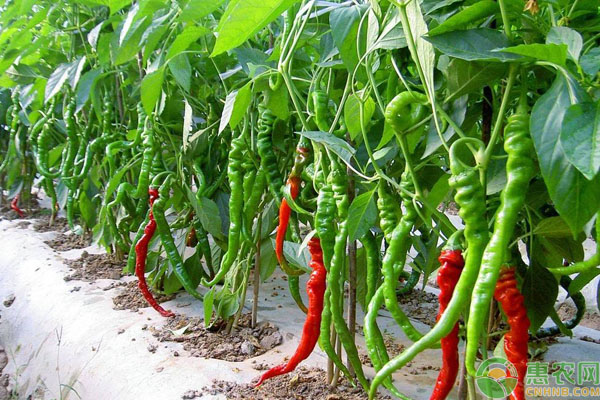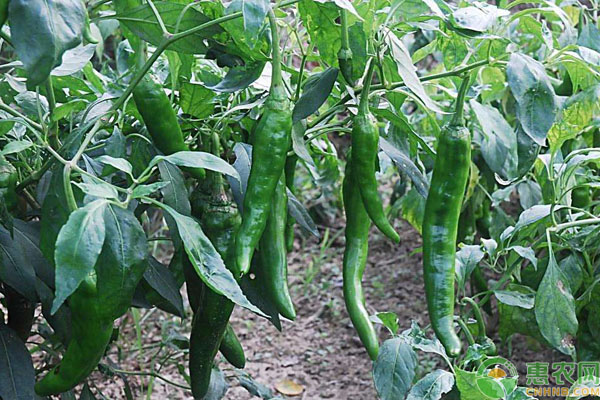Technical points of pepper cultivation and management
Pepper is grown in many areas. The main methods of planting are open field and greenhouse. Comparing the two, the most common one is open field cultivation. So how can high-yield and high-quality cultivation in open field? What management should be paid attention to? Let's take a look at it.

Key points of cultivation technology of pepper open field
1, nursery
After the Ching Ming Festival, the spring-sowed dried peppers were planted with the open-air wind barriers, or after the final frost, live in the exposed rains in the valley to the summer, and the high-altitude and high-altitude areas were broadcast live in the open days 10 to 15 days after the summer. The seedbed should be applied with the base fertilizer, planted with the bottom water, seeded, soaked and seed treated, spread or stripped, and covered with small arched membrane insulation after sowing.
After the seedlings are out, the temperature should be gradually ventilated during the daytime temperature of 27 °C ~ 28 °C, and the vents should be closed in the afternoon. The cotyledons grow up, and the true leaves grow 1~2 pieces. The outside temperature rises and the night frost has passed. It is necessary to remove the membrane early and remove the wind barrier. Because of the dry wind in the spring, the seedbed exposed to the ground is easier to dry, affecting the growth of the seedlings, it is necessary to slip the water once in a timely manner, and then cover the soil after the water. Can be divided into seedlings, until the seedlings grow to 10~12 leaves, 50% of the buds are planted. Pay attention to the control of aphids and mites during nursery.
2, colonization
Dry pepper seedlings, arrange more wheat stubble after harvesting, or use vegetables that have not been planted with solanaceous crops for many years. The cultivation of hoeing and fertilization is the same as that of sweet peppers, but the amount of base fertilizer can be reduced by 3 to 40%, mainly by applying cool fertilizer. The ground preparation trench cuts the ridge. Rainproof is better. The ridge method, ditching at a distance of 70 cm, in the middle of the slope on both sides of the ditch, planting double rows of pepper seedlings, small row spacing 25~30 cm, six distance 30 cm, from planting 2~3 plants, 12,000 meters per 667 meters~ 18,000 plants. After the seedlings grow, gradually loosen the ridges to prevent lodging and rain. Traditional practice: Ditching and planting at a distance of 50 cm, six centimeters 30 cm, 2~3 plants, and 0.9 million to 12,000 plants per 667 square meters.
1~2 days before planting, the seedling bed is filled with water to raise the seedlings, and the seedlings are placed in the hole with the wet soil to avoid the large seedlings. If the temperature of the temperature is high during planting, timely planting water, 3 or 4 days of irrigation 2 water or 3 water slow seedlings, timely ploughing and soiling after watering, water control seedlings. Pay attention to the drainage after rain and loosen the soil in time to promote the growth of pepper. Because the base fertilizer is sufficient at the time of planting, the soil fertility is better, so it is not necessary to topdress early, until the fruit-bearing period of fruit-bearing period, start topdressing and heavy fertilization, and apply 20-25 kg of ammonium sulfate per 667 square meters. Full-time long-term topdressing 2 times, 15 days before the frost, red pepper ripening period, avoid nitrogen fertilizer to prevent greed, generally control water and fertilizer. Pay attention to the hazards of mites, cotton bollworms, tobacco budworms and mites, and prevent them in time. 200-400 kg of dried chili per 667 square meters.

3, live broadcast of thousands of peppers
In areas with dry areas and lack of water or labor, it is mainly cultivated in densely planted areas. After applying the base fertilizer, the ground is turned deep and made into a flat shovel, and the ditch is sown, with a line spacing of 15 to 20 cm and a groove depth of 2 to 3 cm. The seeds are sterilized and soaked in warm water, drained, air-dried and seeded, and 1 to 2 seeds per 1 cm, and 400 to 500 grams per 667 square meters.
After the sowing, return to the soil, floor level, irrigation 1 time permeable, 2 to 3 days after shallow ploughing loose soil protection, 10 to 15 days of emergence, and then water once, to protect the seedlings, water after the soil should be loose, not more irrigation. When the soil is dry, the water is re-irrigated once and the soil is shallowly ploughed, and the soil is protected by shallow tillage. Topdressing 2 times in the whole life, about 20 kg of ammonium sulfate per application. In areas without irrigation conditions, it is advisable to grasp the loose soil after the rain, or to bury the fertilizer and fertilizer before the rain.
4. Harvesting and drying of thousands of peppers
Natural air drying method. Before the frost, the pepper seedlings were uprooted, spread out, and dried to 80% dry. With the temperature drop, the yard or courtyard was taken back and batched. Root roots, pepper and pepper, fruit, code 1 ~ 1.5 meters high, pepper fruit to the sun, or roots in the pepper towards the outside into a round, then gradually close the top, naturally dried. Pick up the pickled fruit and relax it during the slack season. This method is only suitable for short-term exposure, which will cause red pigment decomposition and reduce quality in the long-term.
Another natural air-drying method is to pick red ripe fruits in the autumn cool and air dry seasons, and wear them in a string in a timely manner. Hang them under the ventilated eaves and beams, and dry them naturally. The color of the peppers is good, but not Mass production.
Artificial drying method. The building of the baking room is artificially heated and baked, which is suitable for mass production in the pepper area. The quality is also good and the color is bright.

The above is the introduction of the cultivation technology of pepper open field. The contents of each period have been introduced in detail. Everyone can refer to it during planting. I hope that the content shared by Xiaobian can help the majority of growers.
Recycled Waterproof change Robe
We are the supplier of Dry robe supplier for more than 8 years, Our main product is surfing dry robe, beach change robes. towel robe, recycled waterproof dry robe and etc.
Our dry robe is 100% waterproof and recycled, with two big outside pocket,reverse YKK zip, fleece warm lining and etc.
We also use the long sleeve or short sleeve Waterproof Change Robe for winter surfing, camping, cycling, hiking, paddle and water sports.
Recycled Waterproof change Robe,Beach Surfing Robe,Swimming change Robe,Long Sleeve Change Robe
Suzhou Golden Gamrnet MFG Co.,Ltd , https://www.suzhoumfg.com